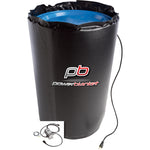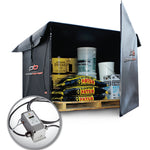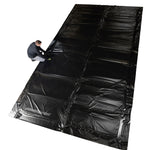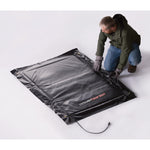You have no items in your shopping cart.
Article At-a-Glance
How Do Immersion Heaters Enhance the Brewing Process?
Immersion heaters are efficient devices that quickly heat large volumes of liquid by passing an electric current through a tubular element, offering home and craft brewers precise temperature control, flexibility across brewing stages, and cost-effective solutions for small-scale operations.
Key Takeaways
- Understand Immersion Heater Functionality: Immersion heaters efficiently heat large volumes of liquid by passing an electric current through a tubular element, making them ideal for precise temperature control in brewing processes.
- Evaluate Pros and Cons: Immersion heaters offer flexibility, fast heat-up times, and cost-effectiveness for small-scale brewing, but may lack precision and can risk scorching if not monitored properly.
- Choosing the Right Heater: Consider factors like power output, temperature control, and installation requirements to select an immersion heater that suits your brewing needs and setup.
- Practical Tips and Best Practices: Ensure proper installation, regular monitoring, and adherence to safety guidelines to maximize the effectiveness and safety of your immersion heater in brewing.
- Real-World Insights: Learn from other homebrewers' experiences through forums and reviews to make informed decisions about using immersion heaters in your brewing process.
Immersion Heaters for Brewing: Pros and Cons
Brewing immersion heaters can be a huge help in controlling temperatures in the beer-making process. Read on to learn how immersion heaters can benefit your brewing operation.

$484.00 USD
1" NPT Screwplug Heater w/ Thermostat - Brass Plug Copper Element (2000W, 120V)
For better temperature control in brewing, consider using screwplug immersion heaters. These heaters are designed to improve your immersion heating process effectively.

What are immersion heaters and how do they work?
An immersion heater is a device that is used to heat water or other liquids. It is a small, tubular device that is inserted into the liquid that is to be heated. The heater then warms the liquid by passing an electric current through it. Immersion heaters are a great way to heat your brewing water properly. They are quick and easy to use, and they can heat a large volume of liquid at a fast rate. This often makes them the perfect choice for heating your water for brewing.
Why is temperature control important for brewing?
Temperature control is a critical aspect of the brewing process, as it greatly affects the flavor, aroma, and quality of the final beer. Proper temperature control is essential during various stages of brewing, including mashing, fermentation, and conditioning.
Brewing immersion heaters, such as screwplug immersion heaters, can be used in several stages of beer-making. But before we discuss how to do that, let’s go over the pros and cons of using immersion heaters in brewing applications.

The pros of using immersion heaters for brewing
Immersion heaters can provide plenty of value for brewers, especially for those making beer in smaller batches (i.e., not a major beer manufacturer, but a local brewery). Immersion heaters can provide the following:
- Flexibility: Immersion heaters can provide flexibility in terms of controlling the temperature of the brewing process. They can be used in various stages of brewing, such as mashing, boiling, or fermentation, and can be adjusted to achieve precise temperature control according to your specific recipe and brewing style.
- Fast heat-up time: Electric heating elements like those used in immersion heaters can bring liquids to a specified temperature quickly, especially compared to non-electrical heating methods.
- Portability: Brewing immersion heaters are typically portable and can be used in different vessels, such as kettles or fermenters, allowing for flexibility in different brewing setups or locations.
- Cost-effective: Compared to some other brewing equipment with built-in temperature control systems, immersion heaters tend to be more affordable, especially for handcrafted brewing operations or DIY setups.
- Small-scale brewing benefits: Immersion heaters are most suitable for smaller-scale brewing setups, such as home brewing or experimental batches, where dedicated brewing equipment with built-in temperature control systems may not be available or affordable. They give homebrewers more options and allow for a wider range of brewing recipes to be used.
Craft breweries and home brewers that rely on immersion heaters for temperature control know the value that immersion heaters provide. Consistent, reliable heat brings peace of mind to brewers knowing their brewing processes have the right amount of heat to create the ideal beer.
The cons of using immersion heaters for brewing
Using electrical heating elements for brewing won’t always work in every circumstance. Below are several reasons why immersion heaters might not be the best choice for temperature control:
- Limited precision: Immersion heaters don’t always offer the same level of precision and control as dedicated brewing equipment with built-in temperature control systems, such as glycol-cooled fermenters or professional-grade brewing systems. Achieving consistent and precise temperature control with immersion heaters may require careful monitoring and adjustments.
- Risk of scorching or off-flavors: Immersion heaters that aren’t installed correctly or aren’t monitored effectively can potentially scorch the liquid or create hot spots, resulting in off-flavors or undesirable effects on the quality of the beer. Proper stirring, monitoring, and temperature control are crucial to avoid these issues.
- Brewing volume limitations: Immersion heaters may have limitations in terms of the volume of liquid they can effectively heat. Larger brewing operations with high volumes of liquid may require more powerful and specialized equipment for efficient temperature control.
While large operations might not benefit from immersion heaters, smaller breweries will find that immersion heaters offer confidence in controlling temperatures during different stages of the brewing process.
What parts of the brewing process require temperature control?
Immersion heaters can be used for temperature control in various ways during the brewing process, including regulating heat in the mash tun, boil kettle, fermentation vessel, conditioning vessel, and during cold crashing. They help maintain the desired temperature during each stage of the brewing process, making them a critical piece of equipment for achieving desired flavors, aromas, and characteristics in the final beer.
Do you need a special homebrew immersion heater for making beer at home?
While specialized immersion heaters for homebrewing are available to buy, they’re not always necessary for making beer at home. Immersion heaters specifically designed for homebrewing are typically tailored to the individual needs of brewers and may offer features such as precise temperature controls, durable construction, and ease of use. Even so, many homebrewers use standard immersion heaters that are readily available in the market or repurpose other heating elements for their brewing needs.

With the right immersion heater providing adequate temperature control options, you can be sure to produce high quality beer.
Tips for properly using a brewing immersion heater
Using immersion heaters to effectively heat tanks and vessels in brewing isn’t that complex. However, it’s smart to know a few best practices when installing and operating an immersion heater:
- Follow manufacturer's instructions: Carefully read and follow the manufacturer's instructions for installation, operation, and maintenance of the immersion heater. This includes proper electrical connections, grounding, and any other safety precautions provided by the manufacturer.
- Clean and sanitize prior to use: Before using the immersion heater, ensure that it is clean and sanitized. Cleaning and sanitizing the heating element thoroughly will help prevent any contamination of your brewing liquids.
- Use a dedicated electrical circuit: Immersion heaters typically require significant electrical power. Use a dedicated electrical circuit with the appropriate electrical capacity and breaker size to safely power the immersion heater.
- Monitor liquid temperature: Use a suitable temperature controller or thermometer to monitor the temperature of the liquid being heated. Avoid overheating or scorching the liquid, as it can negatively affect the flavors and quality of your beer. Follow the temperature guidelines for the specific stage of brewing you are in, such as mashing, boiling, or fermentation, to achieve your desired results.
- Stir the liquid: To ensure even heat distribution, stir the liquid periodically during the heating process, especially if you are using an immersion heater in a mash tun or boiling kettle.
- Maintain safety: Always take appropriate safety precautions when using an immersion heater. Avoid contact with the hot heating element or the heated liquid. Use heat-resistant gloves and other protective gear as needed. Keep unauthorized personnel away from the brewing area when using an immersion heater.
- Follow local regulations: Ensure that you comply with all local regulations, codes, and guidelines related to the use of immersion heaters in brewing, including electrical safety, food safety, and environmental regulations.
- Clean and store properly after use: Following the use of your brewing immersion heater, clean and sanitize your equipment according to the manufacturer's instructions. Store the immersion heater in a dry, safe place to prevent damage and ensure its longevity.
How to choose the right immersion heater for your needs
When choosing the right electric process heater, including immersion heaters, for your brewing needs, there are a few things to keep in mind:
- Heating volume: Consider how much water you need to heat. Most immersion heaters can heat up to one or two gallons of water at a time.
- Type of liquid: Decide what type of liquid you will be heating. Most immersion heaters are designed to work with water, but some can also be used with oils or other liquids.
- Power rating: Select the power rating you need. Immersion heaters come in various power ratings, so choose one that is strong enough to heat the amount of liquid you intend on warming.













